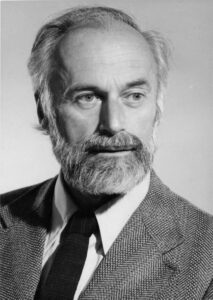Joost A. Businger
Emeritus Professor of Atmospheric Sciences
March 29, 1924 – December 2023
Colloquium
In recognition of his distinguished career as a faculty member, a remembrance celebration of Joost Businger was held at the University of Washington at 3:30 pm, Friday, May 24, 2024, in ATG 310.
“For pioneering atmospheric boundary layer research”
by Steven Businger
In December 2023, just before his 100th birthday, Joost Businger, a pioneer of modern boundary layer meteorology, passed away. Joost was born in Haarlem, The Netherlands. At a young age, a warm day in March inspired in him a lifelong passion for weather. His grandfather was a Swiss immigrant to Amsterdam, who passed to Joost Swiss citizenship through his father Leopold Alois Businger. A Swiss passport allowed Joost to pursue studies in physics at Utrecht University in 1942, unhindered despite the German occupation.
Meteorology wasn’t available as a specialization at the time in the Physics Department, so he delved into heat transfer research under Professor van der Held, where he learned that turbulent exchange could be addressed through dimensional analysis. He graduated in 1947 and found a job at the Institute for Horticultural Engineering in Wageningen, working four days a week, allowing him three days to work on his dissertation in Utrecht. He married in 1949. In Wageningen, he worked on greenhouse climate and developed a method for frost protection that is still in use today.
Joost’s dissertation, which he completed in 1954, focused on turbulent exchange processes in the atmospheric surface layer (ASL), the first ~100 m of the atmospheric boundary layer (ABL). He introduced the concept of “roughness length” as a relevant length scale, independently of Russian researchers Monin and Obukhov (MO, 1954), who introduced the Obukhov length as the relevant length scale. Joost soon accepted that the MO theory was more adequate than his own approach. However, it should be noted that in later studies, the roughness length was shown to be a relevant length scale.
Joost was one of the first to recognize that the ABL was important in weather and climate models, because it forms the interface between the free atmosphere and the Earth’s surface. Joost realized how much research was needed to establish the link between synoptic meteorology and boundary layer meteorology. Joost was a pioneer in this field! There was little support available for young scientists in the Netherlands in 1956, so Joost took a research associate position at the University of Wisconsin. One of his initial tasks was to work on raw data collected with a sonic anemometer developed by Soumi.
In 1957, Joost became an assistant professor at the University of Washington (UW). Together with his first student Kaimal, he further developed the sonic anemometer and adapted it to measure turbulent fluxes using an eddy correlation method. During a sabbatical in Australia in 1965-66 with Dyer and Swinbank, the theoretical basis was laid. This led to the Dyer-Businger MO relationships. These profile descriptions were finalized during the Kansas 1967/1968 field experiment organized by the Air Force Cambridge Research Laboratories, where Kaimal had found a job. This led to Businger et al. (1971, JAS, 28, 181–189), Joost’s milestone paper on MO flux-profile relationships, an article that has been cited nearly 5000 times. This milestone paper was a logical consequence of the ideas developed as a student in Utrecht during the war.
Nowadays, sonic anemometers are used worldwide with digital data loggers. However, at that time, strips of x-y writers had to be processed manually, which was a painstaking task, making the milestone article even more remarkable. He considered other topics he tackled equally important. For a detailed description of Joost’s further career, see de Bruin & Nieuwstadt (BLM 2004) and Steven Businger (BAMS 2024).
While on Sabbatical at KNMI in 1975, Joost wrote his first article on atmosphere-ocean interactions and he fostered new collaborations, thereby contributing to a rich tradition of boundary layer research in The Netherlands.
As an author of textbooks, Joost’s knowledge remains highly influential. See Fleagle & Businger, An Introduction to Atmospheric Physics 1980; the Workshop on Micrometeorology 1973, A Short Course on Atmospheric Turbulence and Air Pollution Modeling 1982, and Kraus, & Businger Atmosphere–Ocean Interaction 1994.
After early retirement from UW in 1982, Joost moved to NCAR in Boulder and developed the ASTER facility to promote ABL research. He also worked on the conditional sampling method (or relaxed eddy accumulation approach) with Steven Oncley and which has been patented. In 1989, he retired and designed and helped build a sustainable house in the San Juan Islands in Washington State. Nature conservation and judicious use of energy and water became themes in his life. Joost will be remembered as a kind and modest man who, despite his worldwide fame, was approachable to young researchers. He is survived by his wife Marianne and three children, Ferdi, Steven, and Margi and two stepchildren Bret and Erica.
